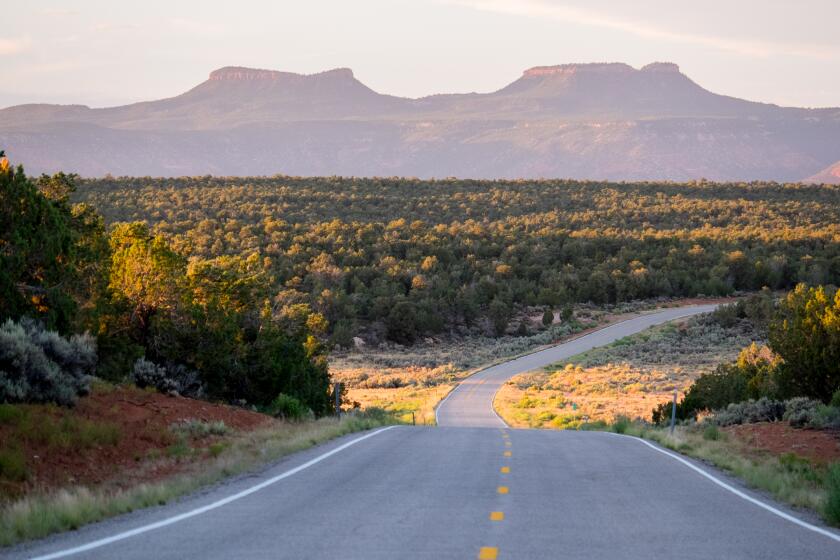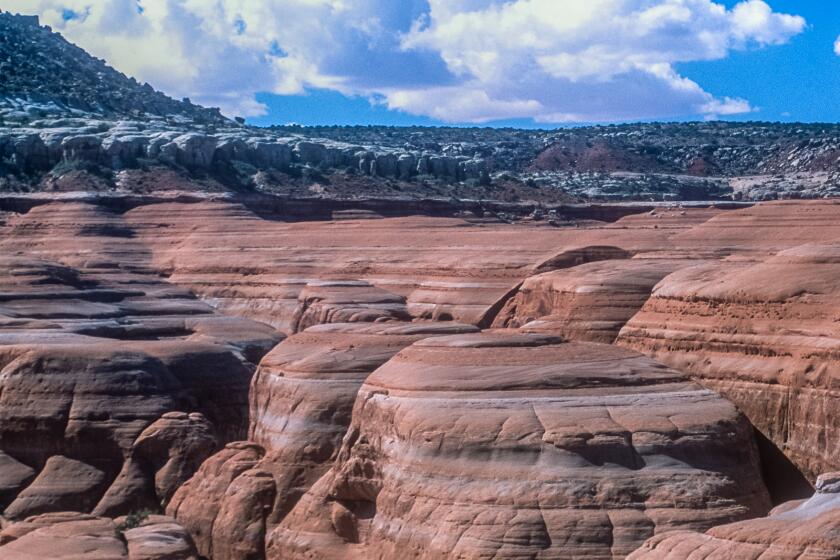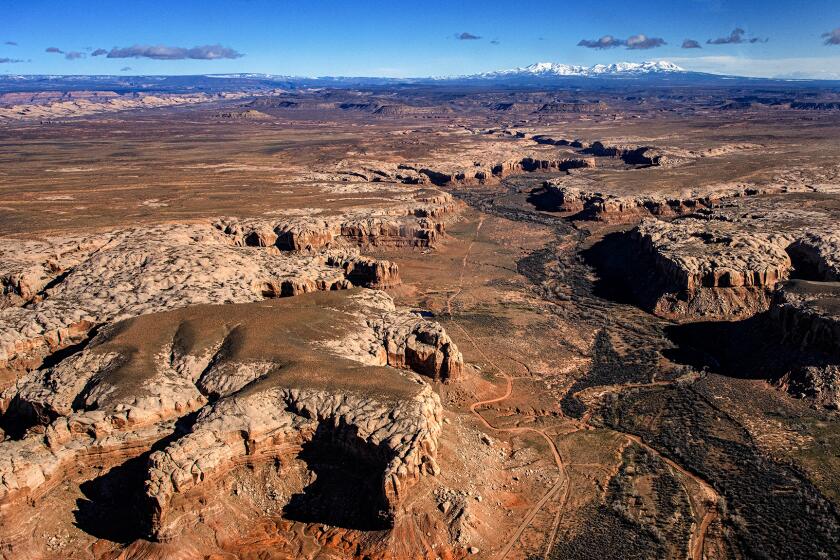Opinion: The 2024 election will conserve or break apart cherished public lands

- Share via
“Two white guys in suits, two interchangeable politicians? It makes little difference who wins.”
As the 2000 presidential election approached, two of my closest friends wouldn’t budge from this cynical and dispiriting view. I’m still furious. Think where we would be with climate legislation if Al Gore had beaten George W. Bush. And would we have invaded Iraq?
Every president makes near-daily decisions of global and national import. Every new staffing and policy choice affects each of us in countless ways.
I’m canvassing for Harris this fall in swing-state Arizona. At every doorstep, I ask, “What do you care about?” Kids? Healthcare? Jobs? Prices? Immigration? Democracy?
For every issue, Kamala Harris and Donald Trump have wildly differing policies and instincts. Who wins does make a difference.
Trump reduced national monuments before Biden restored them. The Project 2025 blueprint says public lands need to remain open to a wide range of uses.
One of my own answers to “what do you care about?” is “public lands.” I live in Utah, where state leaders are fiercely anti-federal-government. Public lands here need all the help they can get.
All Americans share ownership of two-thirds of Utah’s great reaches of deserts and mountains. The state’s elected officials deeply resent this fact. They attack every conservation initiative and new national monument. Utah’s Legislature funds futile lawsuits, most recently an effort to persuade the U.S. Supreme Court to hand over management of 18.5 million acres of “unappropriated” federal lands to the state. Any lands administered by the Bureau of Land Management not within national parks, monuments or wilderness would disappear from the national public trust and be subject to the whims of the Legislature, with a Republican supermajority weighted toward land developers.
Utah’s ruling party definitely knows how Harris and Trump differ in support for such privatization schemes. Democrats demonstrate consistent concern for our long-term future, for preserving biodiversity, for restraint in development. Republicans never relent in pushing for deregulation, unfettered growth and maximum profit.
We’ve seen the consequences for Utah.
Utah’s public-lands-hating Republicans called it an insult, but the restoration of Bears Ears and Grand Staircase-Escalante is a win for Native Americans, nature and all of us.
President Clinton proclaimed Grand Staircase-Escalante National Monument in 1996. President Obama added another majestic national monument at Bears Ears in 2016 in a visionary partnership with Indigenous tribes. President Trump casually eviscerated both of these preserves, then President Biden restored them. A reelected Trump would surely again shrink the monuments — an unprecedented policy whiplash.
Ripples from a new administration can swamp rural Bureau of Land Management offices far from Washington. I saw this happen in the George W. Bush administration. After listening to all stakeholders, a planner in the Richfield, Utah, BLM office drafted a resource management plan that gently foregrounded conservation over development. His district encompassed the redrock wildlands surrounding Capitol Reef and Canyonlands national parks and included the remote Henry Mountains and eerie badlands around Factory Butte.
The planner looked critically at the effects of excessive livestock grazing and off-road vehicles. He paid attention to “quiet recreation” and environmental threats. His plan wasn’t radical, but he challenged the status quo.
Utah’s anti-Washington politicians keep trying to make our beloved parks, monuments and wilderness their own
The BLM state director reprimanded him: “This isn’t your plan, it’s mine.” Bush’s national BLM director ordered him to give pro-grazing, pro-extraction local officials more control. Finally, he was removed and replaced with a Bush insider. The approved plan backed fossil fuel development and off-road vehicle use — and was later deemed illegal because it ignored historical, cultural and wilderness resources.
In contrast, under Tracy Stone-Manning, BLM director in the Biden-Harris administration, the agency released the Public Lands Rule in April 2024, enshrining conservation as a key management value. Every decision now must be based on the best available science, including “Indigenous Knowledge,” and tribes are making unprecedented progress toward co-management and co-stewardship of public lands within their homelands.
That planner in the Richfield office 20 years ago would have had the current director’s full support — along with every manager in the hierarchy between them.
Utah’s campaign to transfer public lands to the state misleads with a map of “federally controlled lands” that lumps Native nations and reservations in with national parks, national forests and BLM land. Utah’s pitch for control fails to acknowledge tribal sovereignty, let alone respect the trend toward tribal co-management.
A conservation group hopes to turn a newly purchased Utah ranch into a model for working with tribes to protect wilderness in the American West from real estate developers, mining companies and oil drillers.
The Project 2025 blueprint for a Trump administration seeks to open the maximum acreage of public and tribal lands to fossil fuel development. The document describes this as the government’s “obligation to develop”: minimize regulations, banish “radical” climate action, and rescind the Antiquities Act that presidents use to protect unique and endangered public lands as national monuments.
The “Department of the Interior” chapter was written by William Perry Pendley, acting BLM director in the Trump administration, who calls climate change “junk science.” Pendley credits with pleasure the fossil fuel corporate lobbyists and analysts who wrote Project 2025’s energy section “in its entirety.”
The Biden-Harris administration has taken a dramatically different path, with groundbreaking climate change legislation that speeds up clean energy while not abandoning fossil fuels. New management plans for Grand Staircase and Bears Ears respect the tribes and value conservation. Harris herself, as California’s attorney general, won multiple settlements against corporate polluters. Her campaign platform uses language anathema to Trump, Vance and the authors of Project 2025: “She will unite Americans to tackle the climate crisis as she … advances environmental justice, protects public lands and public health, increases resilience to climate disasters.”
Only one white guy in a suit is running this time, but the differences between Trump and Harris transcend wardrobe, gender, race and life experience. Every acre of public land will bear the consequences of who wins in November.
Stephen Trimble writes and votes in Utah. His most recent book is “The Mike File: A Story of Grief and Hope.”
More to Read
A cure for the common opinion
Get thought-provoking perspectives with our weekly newsletter.
You may occasionally receive promotional content from the Los Angeles Times.













